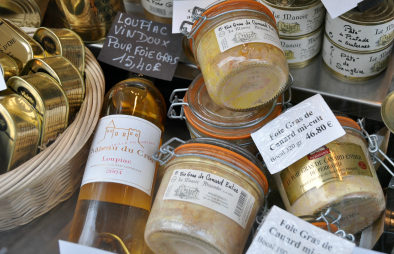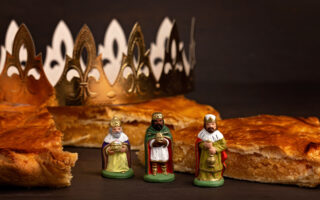Foie gras explained


The various foie gras products and how they are made
A look at the different French foie gras products. If you are not familiar with this delicacy, the various forms of foie gras can be confusing at first. Here is an explanation:
1. Foie gras entier, cru is a whole, raw liver, to be prepared (i.e. to have the vein removed) and cooked, or cured by salting, by you. Scary to look at but very easy to cook and experiment with. To start yourself off, simply heat a dry frying pan and gently fry some slices or chunks of foie for a few minutes on each side. Season and serve with toast, redcurrant jelly, and dessert wine.
2. Foie gras mi-cuit may be seen on restaurant menus. It usually means fresh liver, which will be cooked for your meal, and has not been preserved in any way. The ‘mi-cuit’ (meaning half cooked), refers to the foie gras being cooked rather than raw, but not boiled in a container for 2 hours, as with most preserved versions. If you haven’t tried it, give it a go – it does not taste very liver-like, and it is absolutely divine!
There are also ‘mi-cuit’ versions of the preserves (entier & bloc), which are usually poached in their tins or jars for 30 – 40 minutes, rather than 2 hours or so. These are a completely different eating experience to the mi-cuit fresh foie in restaurants.
3. Foie gras entier, which you will find for sale in tins or jars, is whole liver (or part/s of one, depending on the size of the container), which has been seasoned with salt, pepper and cognac, and then cooked in its container.
[mrb]
4. Bloc de foie gras avec morceaux – ‘morceaux’ means ‘bits’. This is one step up from the plain ‘bloc’, in that it is a pâté made with minced-up foie gras, with little bits of intact liver in it. Its container, in which it has been cooked, will usually specify the percentage of ‘morceaux’ in the pate. (I am not sure how worthwhile it is to pay for these tiny morceaux, but it is a matter of personal taste…)
5. Industrially-produced Bloc de Foie Gras is a pâté made from minced up foie gras and seasoning. However, ‘fermier’ or other home-made versions of bloc are more akin to the industrially-made entier, in that the chef will make his/ her entier with one single piece of liver, and his/ her bloc with several smaller pieces of whole liver. In this instance, the ‘avec morceaux’ variety is unnecessary.
6. Goose or duck? Goose foie gras is pricier than duck (more difficult to produce and less of it about) but lots of people prefer the duck one anyway! Duck is supposed to be tastier, while the goose foie gras is the more delicate option. It’s up to you…
‘Bloc’ is the cheapest way to buy foie gras, but can be just as scrumptious as the preserved ‘entier’. Of course they are slightly different, but the products also vary depending on the producer. It is all a matter of personal preference (and budget). The preserves, which are like the tastiest butter imaginable, are a totally different eating experience to the freshly cooked foie gras, which is delicate and a bit like the marrow from a roast joint, so give both of these decadent luxuries a go!
Find out more about the production and traditions of foie gras
Recipe: figs stuffed with foie gras
Share to: Facebook Twitter LinkedIn Email
More in cooking, courses, dordogne, heating, people, restaurants, wine
By Gemma Driver
Leave a reply
Your email address will not be published. Required fields are marked *



